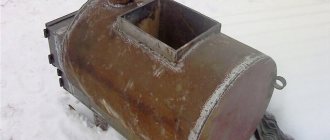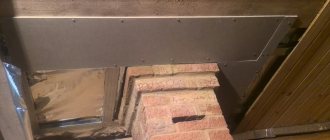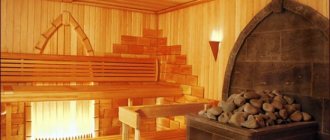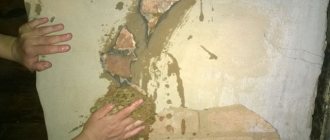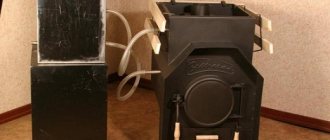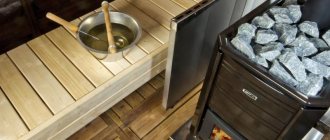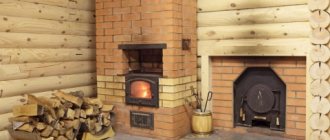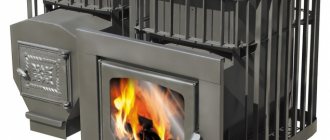How soot is formed and types of blockages
First, we need to understand what we are cleaning from and where it comes from. When wood or coal is burned in the furnace firebox, soot accumulates in the chimney. It is amorphous carbon, a product of incomplete combustion or thermal decomposition of hydrocarbons under uncontrolled conditions. Formed in a pipe as a result of incomplete combustion of any type of fuel (coal, firewood, fuel oil, etc.).
Not only is it formed, it also accumulates. In single-wall pipes, soot collects faster due to the external influence of the atmospheric environment and, accordingly, a sharp temperature difference. In double-walled insulated (sandwich) pipes, the accumulation process is slower. It is important to know that using coniferous logs in a sauna stove leads to more intense soot formation - after all, even dried wood contains resin. Partly for this reason, we most often use logs or charcoal briquettes from deciduous trees.
Logs for the stove
Cleaning the chimney in a bathhouse is not limited to only removing combustion products. Foreign objects from the external environment may accidentally enter the chimney. These could be birds flying in to bask, or even whole nests. As a rule, this happens if the facility is operated in the mode: “...every New Year with friends we go to the bathhouse...”
Determining the time and methods of cleaning
Any foreign formations or objects in the chimney, be it soot or something else from the outside, affect, first of all, your safety:
- weak traction;
- release of carbon monoxide into the room;
- excessive heating of the furnace firebox due to increased thermal insulation of the walls;
- increased fuel consumption;
- destruction of the chimney walls by high temperature.
There is a simple way to determine when it's time to clean. Light a match and bring it to the open oven door. And if the flame is drawn inside the stove, then there is still time.

Checking traction with a match
Alternatively, you can conduct a visual inspection from the roof yourself or invite specialists using video surveillance systems. In the latter case, a video camera with good resolution and backlight connected to a monitor is used. The inspection can be carried out from the inside of the chimney, without access to the roof. But no one has canceled periodic preventive maintenance, at least once a year. Everything can be done in three ways:
- mechanical;
- chemical;
- using folk wisdom.
How to clean a chimney in a bathhouse - we will consider further. The choice of tool and method for removing soot primarily depends on what material the chimney is made of.
Mechanical
There are a lot of options for how to clean a chimney in a bathhouse mechanically, but they have a lot in common. The main cleaning element in the mechanical method is a ruff or brush. They can be made of nylon, polypropylene or metal. When cleaning the chimney from the inside, telescopic extensions made of carbon fiber with a different number of sections are used. There are ready-made kits of different lengths and price categories on sale.
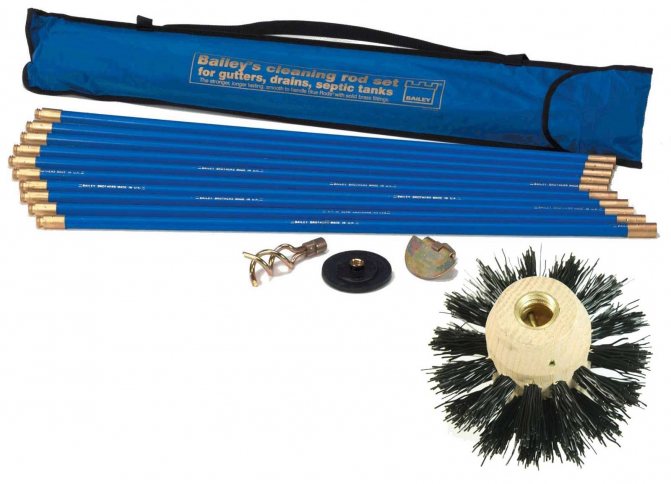
Chimney cleaning device
The operating principle is very simple:
- We screw the brush onto the first section.
- We put it into the chimney.
- Scroll several times until soot stops falling out.
- We screw the second section and repeat the above operation.
- The soot has stopped falling - we disassemble the rod in the reverse order.
- We collect garbage and recycle it.
Don't forget to wear safety glasses and cover the area near the stove with film.
You can use an electric drill or screwdriver. Then you won’t have to rotate the telescopic rod by hand.
In the cleaning method described above, of course, no weighting agents are used, as is the case if work is carried out from the roof of the bathhouse. It will be very useful there. A brush made of polypropylene or nylon is also used as a nozzle. The means of delivering the cleaning element to the chimney can be any strong, proven cable, for example, a plumbing cable with a weighting agent.
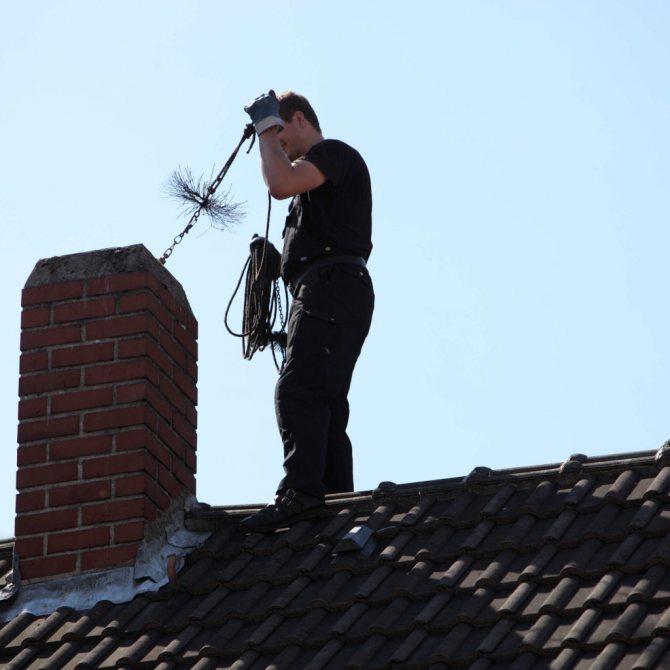
Cleaning a chimney with a weighting agent
The control method of this device is very simple. Slowly lower the brush into the pipe, periodically lift it and clean it of soot.
Be sure to use protective clothing and a safety rope attached to the load-bearing part of the bathhouse.
It is possible to use electromechanical devices to clean the chimney from the roof of the bathhouse. The operating principle of such a vacuum device is similar to the operation of a vacuum cleaner. The only difference: the soot and debris collected in the pipe are not sent to the storage element, but are immediately thrown out of it. Since soot is not considered a fertilizer, it’s worth thinking carefully about: where will it go?
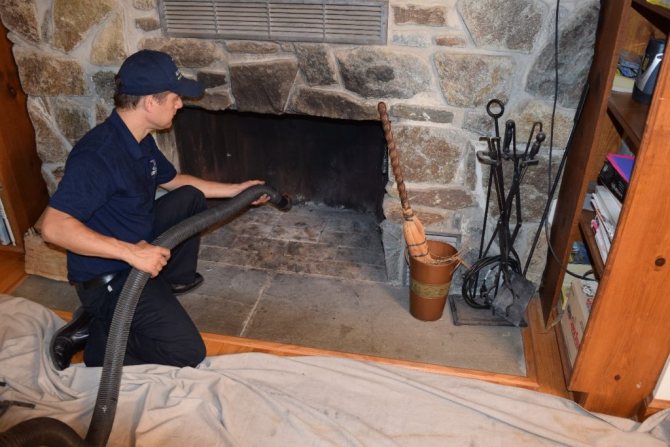
Collecting fallen soot with a vacuum cleaner
Chemical
Cleaning the chimney of a bathhouse from soot using a chemical method, with today’s wide choice of means, is perhaps the most popular method. Light the stove, put in the briquette, and the chemistry will do the rest for you.
Read labels carefully. This method cannot be used in case of mechanical blockage of the pipe and when the thickness of the soot layer is more than 2.5 cm.
Chemical cleaning is harmless to humans, and when used once every 3 months (read the label) it is an excellent preventive procedure.
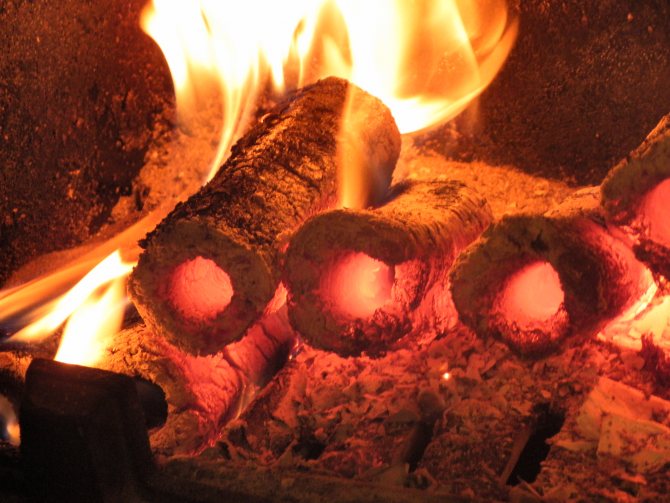
Chemical briquette for cleaning the stove
With all the variety of chemical cleaning agents, the principle of operation is the same for all. The chemical composition burns together with the fuel in the stove, releasing gas that interacts with soot, and it falls down. These products are produced in solid (briquettes, logs) and liquid versions. There are preparations that work several furnaces of the furnace or while it cools down.
Traditional methods
Using traditional methods, you can clean the chimney of soot on your own. Moreover, the methods are easy to combine. For example, simple table salt, previously scattered on logs in the oven, softens the soot in the chimney. But most of it remains in the chimney, and complete removal can only be achieved mechanically.
Using potato peels is also an effective way. A small amount of potato peelings is poured onto the burning fuel. During combustion, starch is released, which, interacting with soot, almost completely removes it from the chimney. Of course, these methods do not give immediate results. So, after burning with potato skins, the soot falls off within a few days.
Another proven method is to throw a bunch of aspen firewood into a heated firebox. When they burn, the temperature rises sharply, which burns the soot in the chimney.
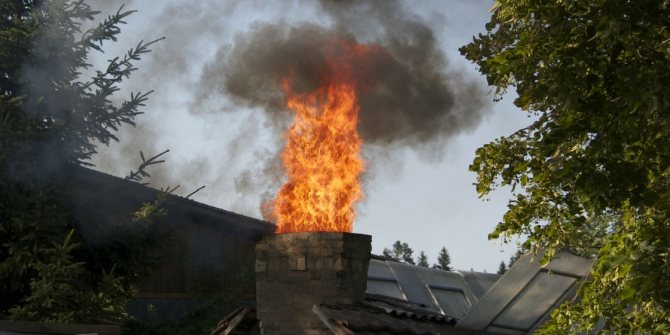
Burning soot in a chimney
But this method can be a fire hazard for the bathhouse and surrounding buildings, since the pipe heats up not only from the inside, but also from the outside. If the chimney is not properly equipped, the materials adjacent to it may catch fire.
Filling a pipe with snow or gradually supplying water into the chimney of a burning stove also has a right to life, but in our opinion, this is troublesome.
Chemical method
Chemical compositions for removing soot deposits quickly and efficiently remove dirt from the wooden surface of the bathhouse, pushing them out.
The advantages of the chemical composition include high efficiency, the absence of harmful elements and toxins, economical consumption, as well as ease of application and safe use.
It is recommended that you carefully study the instructions before using the chemical composition and adhere to them when working with the chemical. Application time varies depending on the composition and manufacturer. If chemical compounds come into contact with the skin or mucous membrane of the eyes, rinse the affected areas with plenty of water and consult a specialist.
Chemical compounds remove plaque quickly and efficiently, without damaging the surface. Such products do not contain substances hazardous to humans, so they can be freely used for treating steam rooms.
To clean wood, simply spread the product over the surface and leave it for the recommended time. The exposure period varies among different manufacturers. After the time specified in the instructions has passed, the composition along with the remaining soot is washed off with warm water.
It is important to let the wood dry thoroughly after finishing the procedure.
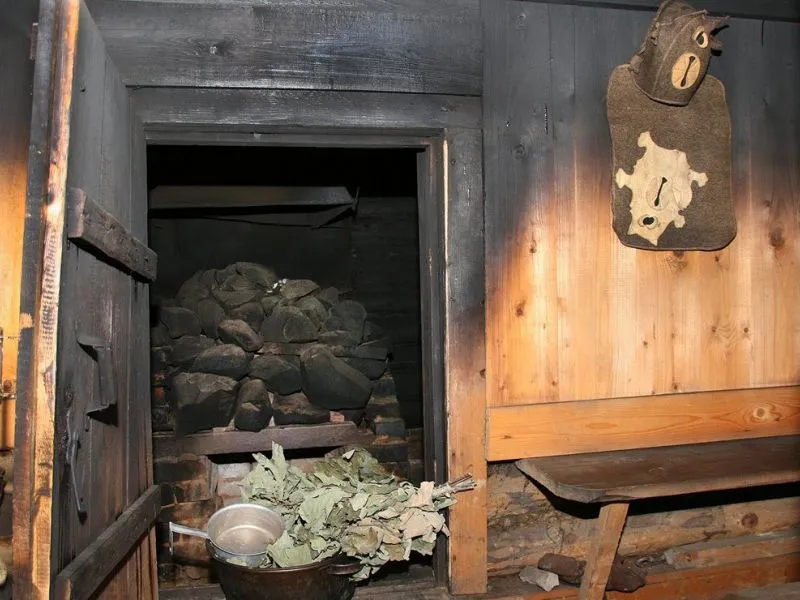
So, you can clean the bathhouse from soot in different ways. Special chemical compounds remove dirt most effectively and quickly.
Prevention measures
It’s not so difficult to clean the chimney of soot using any of the listed methods, including having some potato peels or salt. But it is much easier to carry out preventive measures than to clean the chimney with a vacuum unit or table salt and water. Therefore, at least once every 3 months, inspect the chimney for the formation of “deposits”. When lighting a sauna stove, it is advisable not to use plastic, laminate or other materials that contribute to the appearance of soot. Even if you only heat with birch wood, you will need at least two preventative chimney cleanings per year.
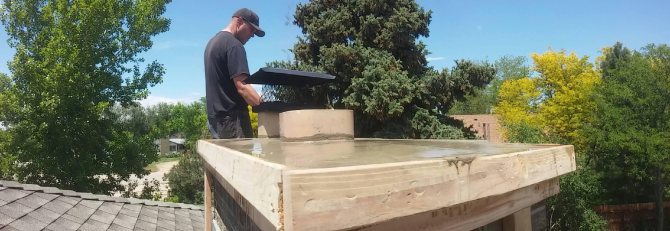
Preventive chimney cleaning
Here's an option: after 10–12 conventional fireboxes, you can burn foil or aluminum packaging material in the oven. The combustion of these materials contributes to the combustion of soot in the pipe.
How to clean a chimney pipe with your own hands: equipment, steps
You can make simple cleaning equipment yourself. This will require a little time and imagination.
Homemade devices
A popular option for mechanical cleaning is a brush made from plastic eggplants, water bottles, and drinks.
The step-by-step process looks like this:
- The label is removed from the container.
- Bottles are cut into strips 1.5-2 cm wide. This needs to be done lengthwise.
- Holes are melted at the bottom of the container with a hot nail so that the wire can pass through. A 5 mm wire is threaded.
- The bottles are inserted into each other through strips and secured with wire.
- The strips are straightened to form a circle.
- All this is attached with a cable or strong rope.
It is important to ensure that the homemade plastic brush and weight go down the center of the chimney and do not twist to the side.
A more reliable alternative is a disc grinder brush. It is durable and suitable for repeated cleaning.
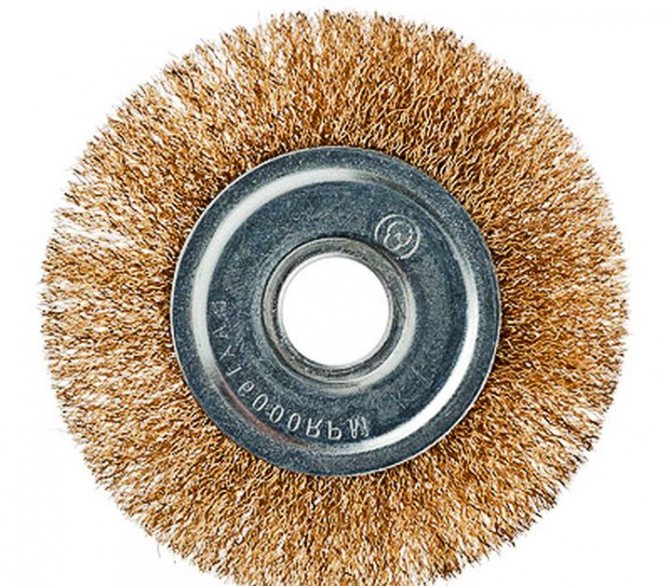
When choosing, it is recommended to take into account that the nozzle and the chimney must match in diameter, since the brush bends poorly.
A 5 kg weight and a rope are attached to the brush. The dimensions of the load are selected so that it is ⅓ smaller than the chimney. For reliability, it is recommended to stretch another rope to the very bottom of the pipe, in case the brush gets stuck. Then you can pull down.
Making a cleaning device
Now you know when and how to clean the chimney in a bathhouse, and you have decided to do it yourself. All that remains is to decide on the method, material, and then assemble the installation you have planned. Everything is clear with the vacuum unit: I saved up (from 30 thousand rubles), bargained and bought it. It’s also easy with organics and aluminum. It’s a little more difficult with a brush, telescopic rod or plumbing cable with a load on board. Most often, for a brush (brush) at home, you need nylon and polystyrene.
You can use a regular plastic bottle or an unnecessary broom made of the same material without a handle.
If you decide to make a device from a bottle, then we take the following materials and tools:
- plastic bottle (one or more);
- scissors;
- pliers;
- wrench;
- 2 washers;
- 2 nuts;
- 2 staples;
- cable.
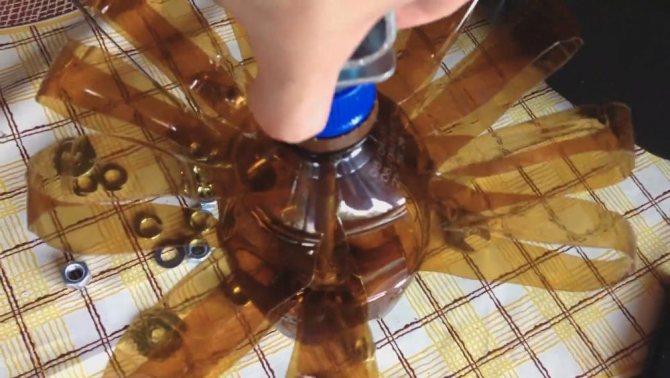
Device for cleaning a chimney from a bottle
Cut the bottle in half, separating half from the bottom. Then we cut along strips (width no more than 1 cm), not reaching the neck, approximately up to the shoulders. We thread a metal pin inside. Using pre-prepared washers and nuts, we tighten the structure so that the cut strips, when bent, are perpendicular to the neck of the bottle. The length of the strips should be greater than the diameter of the chimney; cut off the excess with scissors. If we want the brush to be powerful, then we make plastic attachments from several bottles and insert one into the other. We attach the plumbing cable and weight to the stud through specially prepared brackets.
Features of cleaning
Depending on the type of pollution, the material from which the chimney is made, its design features, it is necessary to take into account the features (tricks) when carrying out work to remove soot. For example, metal pipes should never be cleaned with metal brushes. If you heated a bathhouse with coniferous wood, then when choosing chemical reagents you need to pay attention to whether they will dissolve tar deposits.
If the pipe is clogged with mechanical objects, this means that chemical reagents will not work here. Of course, all work is carried out when the oven has cooled down. Outdoor - in dry, windless weather, using a safety belt. The consumption of alcoholic beverages when working at height is strictly prohibited. The pipe must be freed from the head, and the stove door must be covered with a wet rag to prevent soot from entering the room.
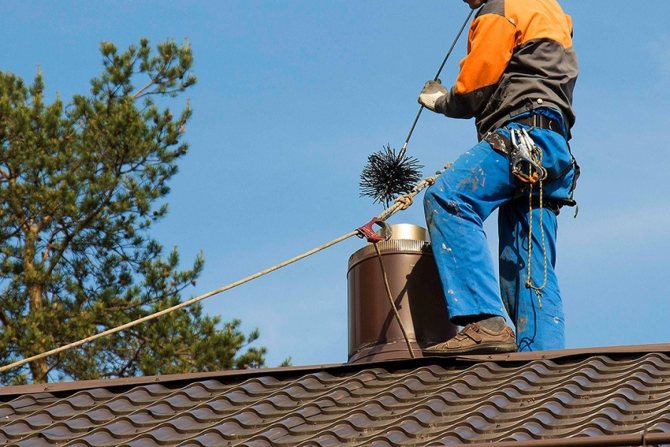
Cleaning a chimney with a load
From tar deposits and soot
In our opinion, the best remedy for the formation of tar deposits is to heat the stove only with birch firewood (drying for a year). But if everything has already happened, you need to use chemical reagents against resins. Those that react with the constituent substances of the resin and contribute to its combustion in the oven. Of course, complete combustion will not work; the remaining part in the form of granules is poured into the combustion part of the furnace. From where it can be easily collected with a vacuum cleaner or a regular brush.
Made of brick and metal
A correctly constructed brick chimney in a bathhouse will reduce the number of mechanical cleanings due to the thermal insulation properties of the brick. There are no sudden temperature changes, and, accordingly, less soot deposits occur in such a pipe. Brick pipes are inspected quarterly. Mechanical cleaning is performed not with a brush, but with a brush.
If you are faced with the question of how to clean a metal pipe, then there are many options. The choice depends on several factors. If a chimney made of a double pipe (sandwich) rises a couple of meters above the roof, it is convenient and safe to clean it mechanically (from the firebox side) or using chemicals.
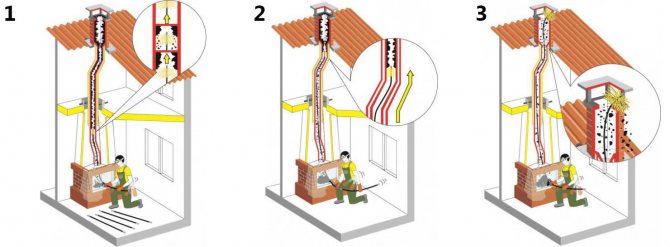
Cleaning with a collapsible cable
Straight and curved
Cleaning straight sections is not difficult. The choice of method depends on the material from which the chimney is made, the frequency of operation of the stove and your capabilities. Cleaning curved pipes is much easier if inspection hatches and no more than two bends are provided during installation. Otherwise, in order to thoroughly clean the chimney mechanically, you will have to disassemble it. If there are inspection hatches, work is carried out in stages. Having opened the first one, we clean the first pipe bend, then move on to the next one.
Mechanical method
The wooden surface of the bathhouse can be cleaned manually using sharp scrapers or similar tools.
You need to scrape off soot deposits very carefully, working through every centimeter, so this method requires serious effort and a lot of time. An alternative option would be to clean the soot after each new heating of the bath using hard brushes so that the deposit does not penetrate deep into the wood. Both options take a lot of time and effort with low efficiency and the danger of damaging the wood. You can make the process easier by using a grinding machine, but after using it, the dust is washed off with soapy water, which is not very convenient and the result does not always meet expectations. During this treatment, only the upper part of the soot deposit is removed, but the smell remains. The disadvantages of this method include a high risk of damage to the wooden surface of the bathhouse and scratches that spoil the appearance of the wood.
You can remove dirt from the surface using a scraper. This cleaning method requires a significant investment of time and effort. It is necessary to carefully consider every centimeter of space. The problem can be solved easier if, after each heating of the bath, you remove fresh dirt using a brush with stiff bristles.
Recommendations for the operation of stoves and chimneys
To prevent the chimney in the bathhouse from becoming clogged, first of all, periodic checks of its condition are necessary, at least twice a year. A draft test before each fire is vital and mandatory.
If possible, use fuel with a low tar content; it is advisable not to burn with coal and peat. To prevent rapid clogging of the chimney, do not burn garbage in the furnace firebox. Insulate the pipe and be sure to cover its top with a cap. It will not allow foreign objects to get inside the chimney. For preventive purposes, you can periodically use certified chemicals that remove soot and tar.
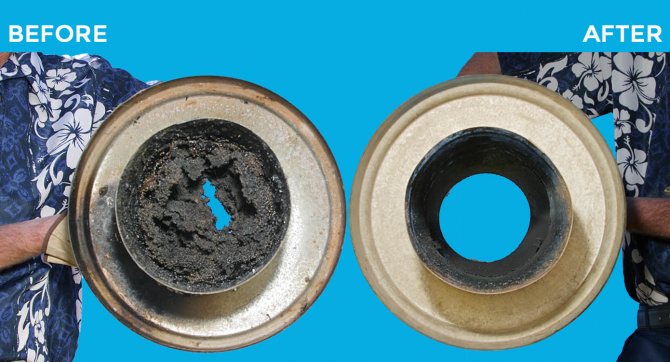
Dirty and clean chimney
The word “bath” evokes direct associations with health and cleanliness. For this to happen, you will need to follow simple recommendations for operation and timely cleaning of the chimney.
